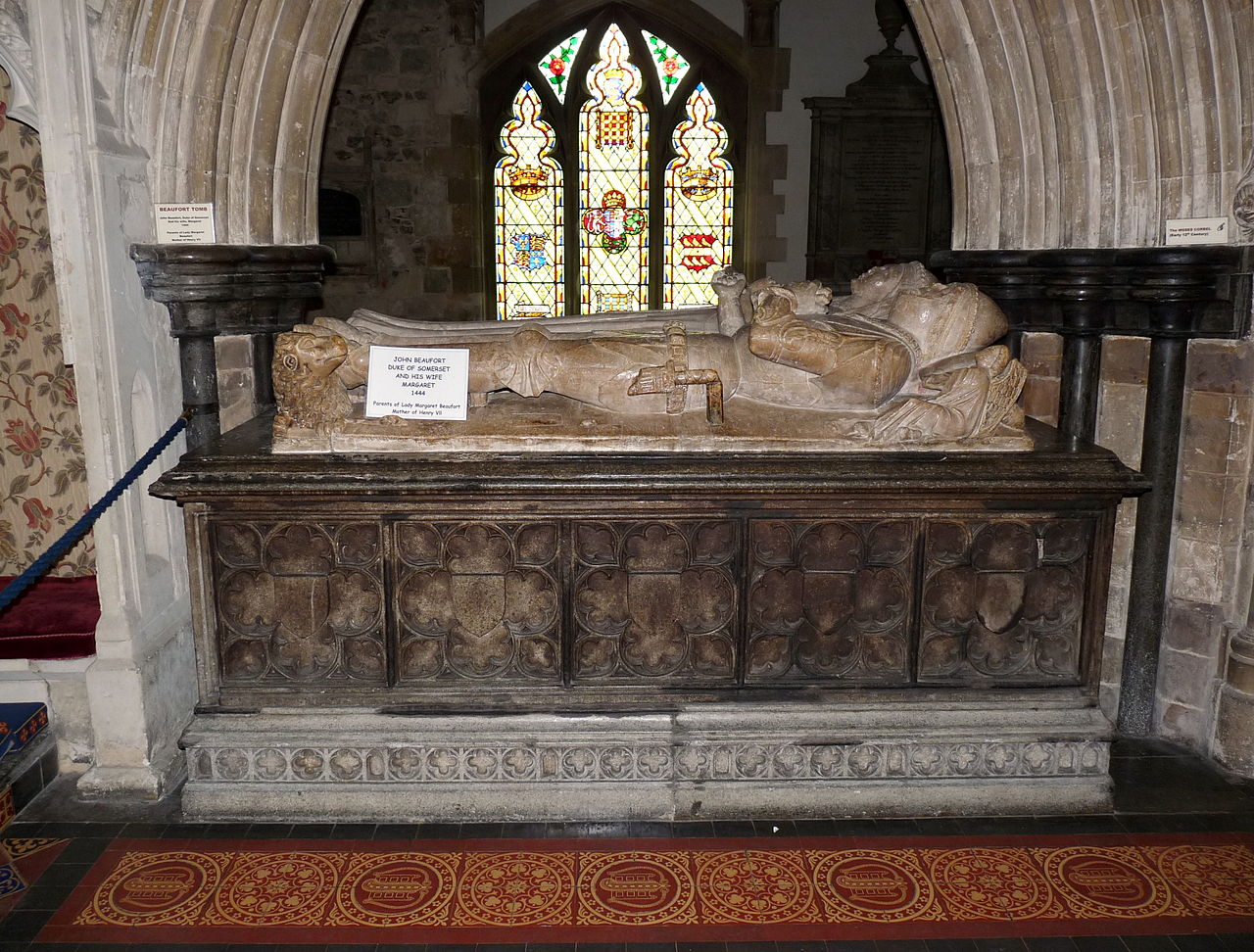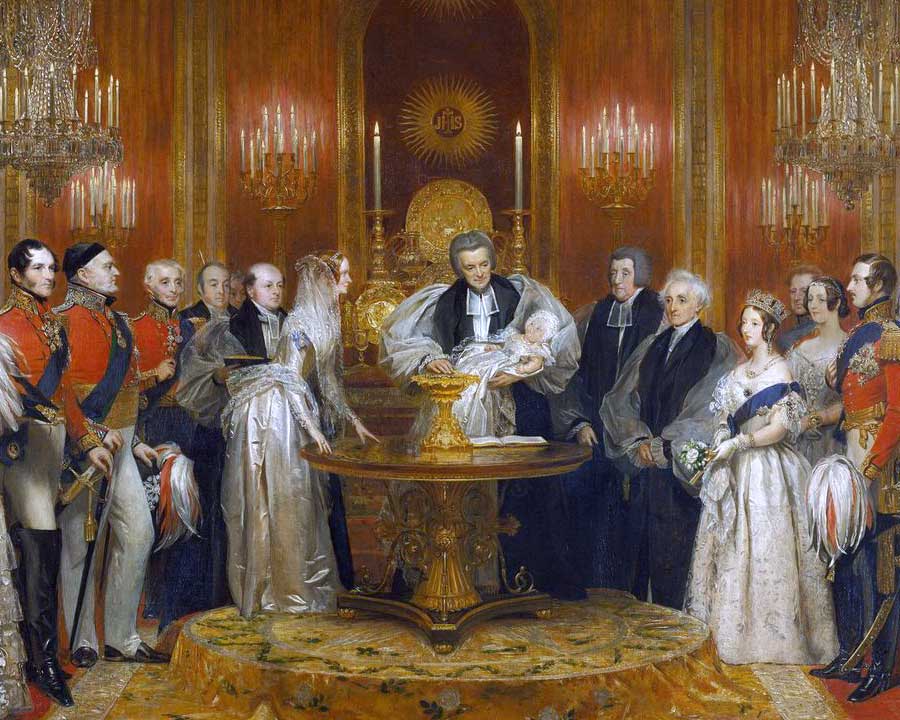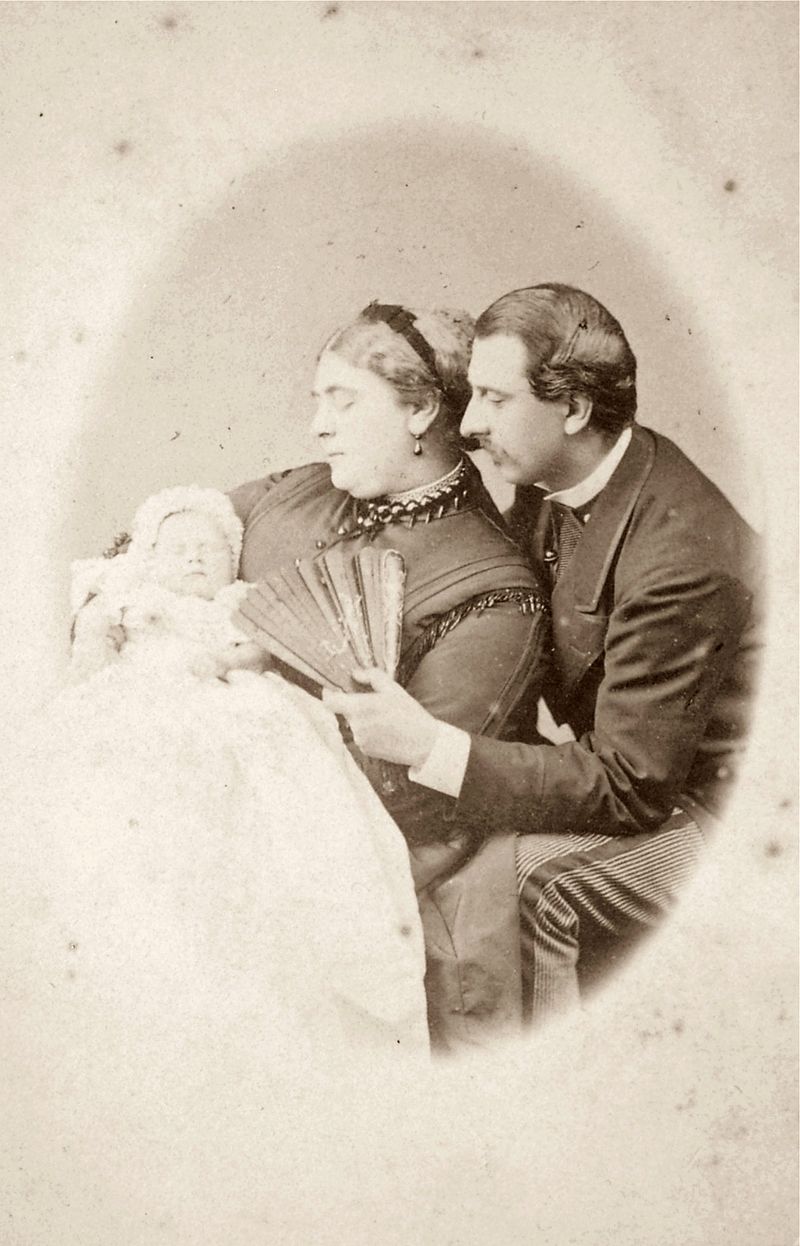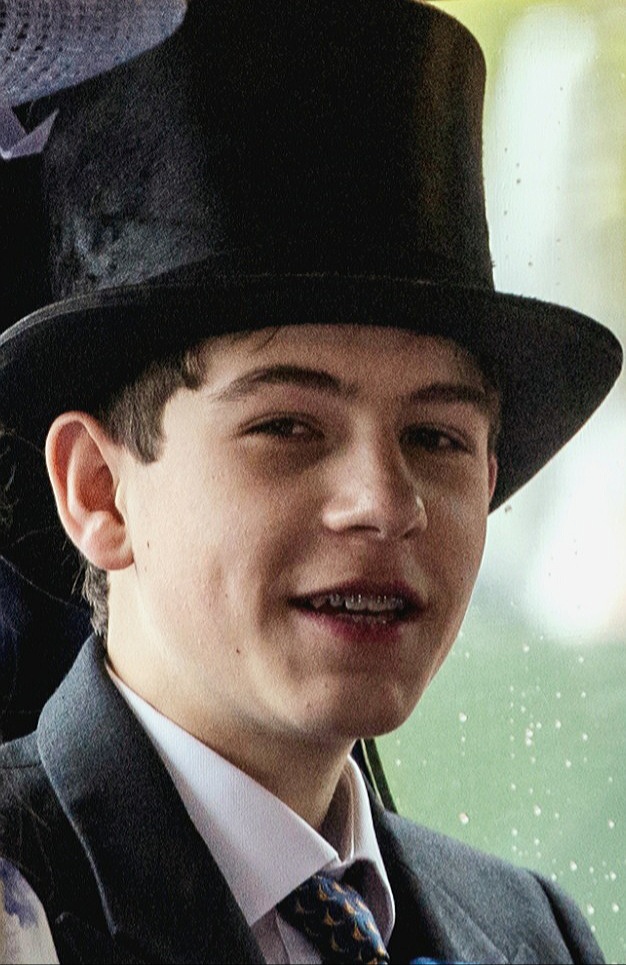by Susan Flantzer © Unofficial Royalty 2019

Lady Margaret Beaufort, Countess of Richmond and Derby; Credit – Wikipedia
Lady Margaret Beaufort, Countess of Richmond and Derby was the mother of the first Tudor monarch, King Henry VII. She lived long enough to see her grandson succeed to the English throne as King Henry VIII. It was through Margaret that her son had his tenuous connection to the House of Lancaster.
Born on May 31, 1443, at Bletsoe Castle in Bletsoe, Bedfordshire, England, Margaret was the only child of John Beaufort, 1st Duke of Somerset and Margaret Beauchamp of Bletsoe. Through her father, Margaret was a descendant of King Edward III of England. Her grandfather John Beaufort, 1st Earl of Somerset was the eldest child of John of Gaunt, 1st Duke of Lancaster (Edward III’s son), and his mistress Katherine Swynford, whom he married in 1396. Their children were declared legitimate by King Richard II of England and Pope Boniface IX, however their half-brother King Henry IV of England introduced a provision that neither they nor their descendants could ever claim the throne of England.
King Edward III of England married Philippa of Hainault → John of Gaunt, Duke of Lancaster married Katherine Swynford → John Beaufort, 1st Earl of Somerset married Margaret Holland → John Beaufort, 1st Duke of Somerset married Margaret Beauchamp → Margaret Beaufort married Edmund Tudor, 1st Earl of Richmond → King Henry VII of England
Margaret had seven half-siblings from her mother’s first marriage to Sir Oliver St John:
- Sir John St John (died 1513/14), married Alice Bradshagh
- Oliver St John (died 1497), married Elizabeth Scrope, daughter of Henry Scrope, 4th Baron Scrope of Bolton
- Edith St John, married Geoffrey Pole
- Mary St John, married Sir Richard Frogenall
- Elizabeth St John (died 1494), married (1) William la Zouche; (2) John Scrope, 5th Baron Scrope of Bolton Agnes St John, married David Malpas
- Margaret St John, Abbess of Shaftesbury
Margaret also had one half-sibling from her mother’s third marriage to Lionel de Welles, 6th Baron Welles:
Margaret’s father was born around 1403. After the early death of his father in 1410, John Beaufort came to the court of his cousin King Henry V as a page and later became a knight and then a military commander during the Hundred Years’ War. In 1421, John accompanied his stepfather Thomas of Lancaster, Duke of Clarence to the Battle of Baugé. His stepfather, a brother of King Henry V, was killed at the Battle of Baugé, and John was taken prisoner. His imprisonment lasted 17 years because Parliament refused to exchange him for Charles of Artois Count of Eu, an English prisoner of war. His uncle Cardinal Henry Beaufort and his brother Edmund never gave up on him and in 1438, there was a prisoner exchange, and John came home to England. After his release, he came to the court of King Henry VI.
In 1439, John married Margaret Beauchamp and in 1443, he was created Duke of Somerset, Commander in Chief of the British forces in France, and a Knight of the Order of the Garter. However, John’s French campaigns failed and Richard Plantagenet, 3rd Duke of York took his place as commander and counselor to King Henry VI. Later, Richard Plantagenet, 3rd Duke of York would become the leader of the House of York during the Wars of the Roses and was the father of King Edward IV and King Richard III. After several disputes with the Duke of York and a couple of military blunders, John returned to England and was banished from the court pending a charge of treason against him. John Beaufort, 1st Duke of Somerset died on May 27, 1444, at Wimborne, Dorset, England, possibly of suicide.

Tomb of Margaret’s parents in St Cuthburga Church, in Wimborne Minster, Dorset, England; Credit – Wikipedia
Margaret was the sole heir of her father. At the time of Margaret’s birth, her father had negotiated with King Henry VI that in the event of his death, the rights of Margaret’s wardship and marriage would be granted to her mother. However, Henry VI reneged and instead granted her rights that came with her extensive land holdings to William de la Pole, 1st Duke of Suffolk, a favorite of King Henry VI. In early 1450, the Duke of Suffolk married six-year-old Margaret to his seven-year-old son John de la Pole, later 2nd Duke of Suffolk. Three years later, the marriage was dissolved and King Henry VI granted Margaret’s wardship to his half-brothers Edmund Tudor and Jaspar Tudor.
Edmund and Jaspar Tudor were the sons of Owen Tudor and Catherine of Valois, widow of King Henry V of England. Therefore, they were the half-brothers of King Henry VI of England. Owen Tudor’s ancestors were from prominent Welsh families. Catherine of Valois was the daughter of King Charles VI of France and Isabeau of Bavaria. There is much debate as to whether Catherine and Owen married. No documentation of marriage exists and even if they did marry, their marriage would not have been legal due to the act regarding the remarriage of a queen dowager.
Even before the annulment of her first marriage, King Henry VI chose Margaret as a bride for his half-brother, Edmund Tudor, 1st Earl of Richmond. In 1455, twelve-year-old Margaret married 24-year-old Edmund. The Wars of the Roses, the fight for the English throne between the House of Lancaster and the House of York, had just started and Edmund, a Lancastrian, was taken prisoner by the Yorkists less than a year later. He died of the plague in captivity at Carmarthen Castle on November 3, 1456, leaving a 13-year-old widow who was seven months pregnant with their child.

Tomb of Edmund Tudor, Earl of Richmond at St David’s Cathedral in Pembrokeshire, Wales; Credit – Wikipedia
Henry Tudor, the founder of the Tudor dynasty, was born on January 28, 1457, at Pembroke Castle in Wales. At birth, Henry succeeded to his father’s title Earl of Richmond. The birth was a difficult one and apparently, it left Margaret unable to have any more children. At the time of Henry Tudor’s birth, the Wars of the Roses was two years old, and his mother, a descendant of the House of Lancaster, was living at Pembroke Castle under the protection of her brother-in-law Jasper Tudor. Jasper Tudor brought up his nephew Henry in Wales, and from 1461 – 1485, when the House of York held the English throne, Henry lived in exile in France under the protection of François II, Duke of Brittany.
Margaret married two more times. On January 3, 1458, still a teenager, she married her second cousin Sir Henry Stafford, son of Humphrey Stafford, 1st Duke of Buckingham. The marriage was a happy one but the couple had no children. Originally a Lancastrian, Sir Henry died on October 4, 1471, from wounds he received fighting for the House of York at the Battle of Barnet, earlier in the year.
Margaret married for the fourth and last time in June 1472 to a Yorkist, Thomas Stanley, the Lord High Constable. Because she was married to a Yorkist, Margaret attended the court of the Yorkist King Edward IV and his wife Elizabeth Woodville and was chosen by Queen Elizabeth to be godmother to one of her daughters.
In 1483, King Edward IV died and was briefly succeeded by his young son King Edward V. Before the young king could be crowned, his father’s marriage to his mother Elizabeth Woodville was declared invalid, making their children illegitimate and ineligible for the throne. King Edward IV’s brother King Richard III assumed the throne. The former King Edward V and his brother Richard, Duke of York (the Little Princes in the Tower) disappeared during the summer of 1483 and their fate is unknown.
Margaret, despite being married to the Yorkist Thomas Stanley, was actively promoting her son Henry Tudor as an alternative to King Richard III. King Edward IV’s widow Elizabeth Woodville and Margaret secretly agreed that Henry Tudor should marry Elizabeth’s eldest daughter. On Christmas Day in 1483, still in France, Henry Tudor pledged to marry King Edward IV’s eldest daughter, Elizabeth of York, who was also Edward IV’s heir since the presumed deaths of her brothers, King Edward V and his brother Richard, Duke of York. In 1485, having gained the support of the Woodvilles, the in-laws of the late King Edward IV, Henry Tudor sailed to Wales with a small French and Scottish force. On August 7, 1485, they landed in Mill Bay, Pembrokeshire, Wales, close to Henry’s birthplace. Henry Tudor then marched towards England accompanied by his uncle Jasper Tudor and John de Vere, 13th Earl of Oxford.

Stained glass window in St James Church in Sutton Cheney, England where it is believed Richard III (left) attended his last Mass before facing Henry VII (right) in the Battle of Bosworth Field; Credit – Wikipedia
On August 22, 1485, at the Battle of Bosworth Field, the last significant battle of the Wars of the Roses, the last king of the House of York and the Plantagenet dynasty, 32-year-old King Richard III of England, lost his life and his crown. The battle was a decisive victory for the House of Lancaster, whose leader 28-year-old Henry Tudor, Earl of Richmond, became the first monarch of the House of Tudor. Margaret’s husband, despite having previously fought for Richard III, did not respond when summoned to fight at the Battle of Bosworth Field. After the battle, Henry Tudor’s men were yelling, “God save King Henry!” Inspired by this, Thomas Stanley found Richard’s battle crown and placed it on the head of his stepson saying, “Sir, I make you King of England.” King Henry VII demonstrated his gratitude to his “right dearly beloved father” by creating him Earl of Derby in October 1485. The following year, King Henry VII gave his stepfather the important positions of Lord High Constable of England and High Steward of the Duchy of Lancaster.

Finding Richard’s circlet after the battle, Thomas Stanley hands it to Henry, Credit – Wikipedia
As promised Margaret’s son married Elizabeth of York, King Edward IV’s daughter and they melded the House of Lancaster and the House of York into the new House of Tudor which reigned in England until 1603. Margaret was alive for the birth of all seven of her grandchildren but only three survived into adulthood. Through her granddaughter and namesake Margaret Tudor, Margaret is an ancestor of the British royal family and many other European royal families.

Double Portrait of Elizabeth of York and Henry VII; Credit – Wikipedia
As the second lady in the land, Margaret was referred to as “My Lady the King’s Mother.” In 1488, she was created a Lady Companion of the Order of the Garter. She endowed colleges at Cambridge University: Christ College and St John’s College. Lady Margaret Hall, the first Oxford University college to admit women, is named after her and has a statue of her in the college chapel.
King Henry VII’s health began to fail in 1507, and he suffered from gout and asthma. He died at Richmond Palace on April 21, 1509, at the age of 52. Margaret was the executor of his will and arranged her son’s funeral and her coronation of her grandson King Henry VIII. On June 23, 1509, Margaret watched the coronation procession of her grandson King Henry VIII from a window. Six days later, the day after King Henry VIII’s eighteenth birthday, Lady Margaret Beaufort died in the Deanery of Westminster Abbey.
Margaret’s tomb, with a gilded bronze effigy, was created by the Italian sculptor Pietro Torrigiano, who also created the beautiful tomb of King Henry VII and his wife Elizabeth of York. Both tombs are in the Henry VII Chapel of Westminster Abbey. Margaret’s tomb is situated between the later graves of her descendants King William III and Queen Mary II and the tomb of her great-great-granddaughter Mary, Queen of Scots. The Latin inscription on her tomb reads “Margaret, Countess of Richmond, mother of Henry VII, grandmother of Henry VIII, who donated funds for three monks of this abbey, a grammar school in Wimborne, a preacher in the whole of England, two lecturers in Scripture, one at Oxford, the other at Cambridge, where she also founded two colleges, one dedicated to Christ, and the other to St John, the Evangelist.”

Tomb of Lady Margaret Beaufort; Credit – Wikipedia
This article is the intellectual property of Unofficial Royalty and is NOT TO BE COPIED, EDITED, OR POSTED IN ANY FORM ON ANOTHER WEBSITE under any circumstances. It is permissible to use a link that directs to Unofficial Royalty.
Works Cited
- En.wikipedia.org. (2018). John Beaufort, 1st Duke of Somerset. [online] Available at: https://en.wikipedia.org/wiki/John_Beaufort,_1st_Duke_of_Somerset [Accessed 8 Sep. 2018].
- En.wikipedia.org. (2018). Margaret Beaufort, Countess of Richmond and Derby. [online] Available at: https://en.wikipedia.org/wiki/Margaret_Beaufort,_Countess_of_Richmond_and_Derby [Accessed 8 Sep. 2018].
- Flantzer, S. (2016). King Henry VII of England. [online] Unofficial Royalty. Available at: https://www.unofficialroyalty.com/king-henry-vii-of-england/ [Accessed 8 Sep. 2018].
- Williamson, David. Brewer’s British Royalty. London: Cassell, 1996. Print.

 Credit – https://www.royal.uk/archie-harrison-mountbatten-windsor
Credit – https://www.royal.uk/archie-harrison-mountbatten-windsor





















































